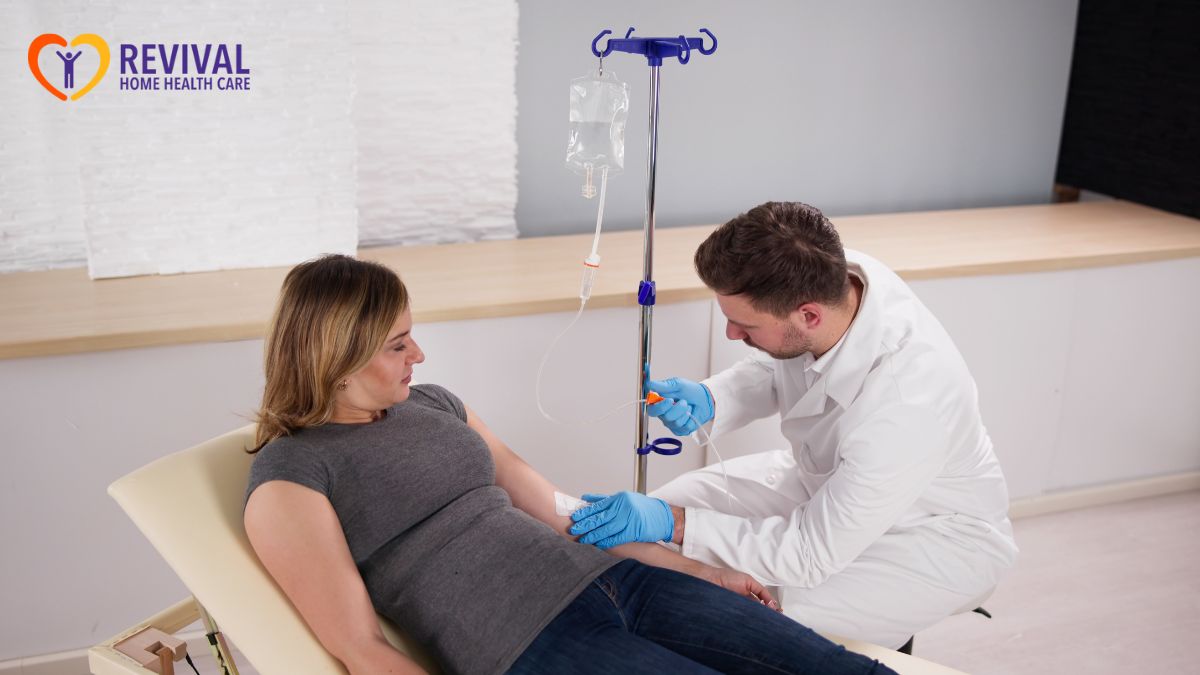Key Points:
- Infusion therapy side effects include tiredness, headache, mild fever, or nausea within 6 to 12 hours, often easing in 1 to 2 days.
- Warning signs include trouble breathing, chest pain, or fever above 100.4°F.
- Staying hydrated, taking premeds, checking your IV site, and reporting symptoms help keep treatment safe.
Infusion therapy side effects include tiredness, headache, flushing, or mild nausea, while serious reactions involve chest pain, breathing trouble, or swelling. Most mild symptoms fade within 24 to 48 hours, but red-flag signs need immediate medical care.
Living with a condition that requires infusion therapy can feel uncertain, especially when you start thinking about possible side effects. Many people wonder, “How do you feel after an infusion?” or “What happens if reactions show up at home?”
Understanding the side effects and learning how to manage them helps you stay prepared, lowers stress, and gives you a clearer sense of what to expect before and after each session.
 Infusion Therapy Side Effects by Drug Class: What’s Common vs. Concerning
Infusion Therapy Side Effects by Drug Class: What’s Common vs. Concerning
Infusion therapy delivers medicine through a vein when pills are too slow, too harsh on the stomach, or not effective enough. Infusion treatment can happen at a clinic, hospital, or at-home nursing.
Knowing what to expect for your first in-home infusion lowers stress. You can plan for a snack, light activities, and a quiet evening. You can also prepare a short plan for handling common reactions and know exactly when to call.
Side effects depend heavily on the medicine and the home infusion therapy plan. The list below groups typical infusion side effects and flags symptoms that need quick care. Doctors tailor premedication and infusion shots or tablets (like acetaminophen or antihistamines) to reduce risk for each class.
Antibiotics (e.g., vancomycin, ceftriaxone)
IV antibiotics treat tough infections. Mild effects include flushing, itching, headache, or stomach upset. Fast vancomycin may cause “red man” flushing, eased by slowing the dose and using antihistamines. Serious signs include hives with breathing trouble, swelling, chest tightness, or sudden low blood pressure.
Monoclonal antibodies and other biologics (e.g., rituximab, infliximab)
Monoclonal antibodies may trigger early infusion reactions like warmth, flushing, rash, or mild shortness of breath. Premeds and slow starts help. Rituximab caused first-dose reactions in 77% of patients, dropping to 14% later, usually mild. Seek urgent help for chest pain, severe shortness of breath, throat tightness, or fainting.
Chemotherapy (e.g., taxanes, platinum agents)
Chemo infusions may cause chills, fever, flushing, or chest and back pressure. Premeds reduce the risk of reactions to docetaxel, decreasing the incidence from 30% to 5%. Red flags are severe breathing trouble, sudden swelling, or severe dizziness.
Iron infusions (e.g., iron sucrose, ferric carboxymaltose)
Iron can cause metallic taste, headache, temporary joint pain, or nausea. Serious reactions are uncommon today but still possible. Severe chest tightness, wheezing, or swelling needs immediate care.
IVIG (intravenous immunoglobulin)
IVIG may cause headache, fatigue, chills, or low-grade fever within 24 hours. Hydration and slower rates reduce symptoms. Sudden severe headache with vision changes, shortness of breath, chest pain, or one-sided weakness needs urgent attention.
Steroids and biologic anti-inflammatories
These infusions are often well tolerated. Some people notice jitteriness, higher blood sugar, or sleep changes for a day or two. Seek help for severe mood changes, confusion, or signs of infection like high fever with chills.
Why this matters to you: Different medicines have different profiles. Understanding your drug’s pattern helps you prepare for and recognize infusion therapy side effects early.
What to Expect on Infusion Day
A few simple choices make a big difference in how you feel right after an infusion.
- Hydration before and after. Drinking water improves vein comfort and reduces headache and fatigue for many people.
- Food is important. A light meal and easy snacks help steady your stomach.
- Move gently. Short walks to the restroom and simple stretches keep stiffness away.
- Layer up. Room temps vary. Bring a sweater, warm socks, and a small blanket.
- Entertainment helps. A podcast, show, or music makes the hours pass quickly.
- Ask about premeds and medication management. If your plan includes antihistamines, acetaminophen, or steroids, take them as directed.
- Plan your ride. Some premeds cause drowsiness. If you are new to a drug or feel woozy, having a driver is safer.
During the infusion, nurses watch your blood pressure, oxygen, and how you feel. Most reactions appear in the first 10 to 30 minutes, which is why rates often start slow. If you feel flushed, itchy, chilled, or tight in the chest, say it right away. Many reactions resolve by pausing the drip, giving a med, and restarting at a slower rate.
Red-Flag Symptoms
You need a clear plan for action. The signs below help you decide what to do fast.
Call 911 or go to emergency care now if you have:
- Trouble breathing, wheezing, throat tightness, or swelling of lips or tongue
- Chest pain, fainting, or confusion
- Severe back or chest pressure that does not ease with a pause in infusion
- High fever with chills after a line flush needs urgent care and close wound care at home follow-up.
Call your infusion nurse or prescribing provider the same day if you notice:
- Rash, hives, flushing, or itch that spreads
- Fever of 100.4°F (38°C) or higher after treatment
- New swelling or redness at the IV site or catheter site
- Nausea or headache that does not improve with usual medicines
- Glucose spikes (if you have diabetes) after steroid premeds
Keep a short script handy. When you call, include your full name, drug name and dose, time symptoms started, temperature, and any medicine you already took.
Central Lines and PICCs: Preventing Infections at Home
Some treatments use a PICC or port for frequent infusions while protecting veins. Proper care lowers infection risk. Rates of CLABSI from home infusion range from 0.19 to 3.6 per 1,000 catheter-days, lower than hospitals but still important.
Daily habits that help:
- Hand hygiene every time. Wash hands or use sanitizer before touching the line or supplies.
- Keep dressings clean and dry. Do not peel early. Cover for showers as instructed.
- Alcohol scrub the hub. Clean the cap for the full rub time before any connection.
- Check the site. Look for redness, swelling, drainage, or tenderness.
- Follow flush schedules and lean on skilled nurses for technique checks. Use the exact saline or heparin routine your nurse taught.
- Use sterile supplies. Store in a clean, dry spot away from pets and cooking areas. A home health aide can help keep the setup clean and organized.
- Know your backup plan. Keep emergency clamp, spare caps, and your nurse’s number in the same bag.
Call quickly for: Fever, chills, new redness or warmth along the catheter, pus, or a line that will not flush.
How Do You Feel After an Infusion?
Most people feel a bit tired or “off” the day of treatment. You might nap more and feel back to baseline the next day. For some drugs, mild symptoms like headache, low-grade fever, or achiness show up 6 to 12 hours later and fade within 24 to 48 hours.
Normal (mild and short-lived):
- Tiredness, slight dizziness when you first stand up
- Mild headache, low-grade fever, or chills that respond to acetaminophen
- Flushing or itching that eases after the infusion slows or stops
- Mild nausea that improves with snacks or an anti-nausea pill
Not normal (call your team):
- Breathing difficulty, chest pain, or pressure
- Fever above 100.4°F (38°C) that does not settle
- Hives that spread, facial swelling, or throat tightness
- Severe or new pain at your IV or port site
Use your discharge sheet to match symptoms with actions. When in doubt, call.
Home Monitoring Checklists
A short daily checklist catches problems early and keeps infusion therapy side effects from snowballing. Print this and keep it with your supplies.
Daily Quick-Check (2 minutes):
- Temperature and how you feel overall
- IV or catheter site: color, swelling, tenderness, drainage
- Line function: flushes smoothly, no leaks or alarms
- Hydration: pale urine, no dizziness when standing
- Bowel habits and nausea control
- Pain score and what helped today
After Each Infusion:
- Any flushing, rash, chills, or shortness of breath during the drip?
- Did the nurse pause or slow the rate? What meds were given?
- How long until symptoms eased?
- Do you have enough premeds and anti-nausea pills for the next dose?
- Did you schedule the next lab draw or clinic check if needed?
Supply Readiness:
- Dressing kits, alcohol caps, flushes, sharps container
- Emergency numbers: infusion nurse, prescribing office, after-hours line
- Backup plan for power outages or travel days
Dosing, Rate, and Premeds
Infusions often start slow and increase step by step. This strategy catches reactions early and limits severity. Many regimens include premeds to reduce infusion treatment reactions, such as antihistamines for itch and hives, acetaminophen for fever and aches, and steroids for drugs known to trigger cytokine release.
For taxane chemotherapy, premeds are standard because they markedly lower reaction rates; as noted earlier, reactions with docetaxel are about 5% with premeds vs. 30% without.
If you had a reaction before, the next plan may add extra premeds, extend the infusion time, or split the dose across two days. Report every symptom, even if it felt small. Your notes help your team make the next session easier.
 Practical Comfort Tips That Patients Swear By
Practical Comfort Tips That Patients Swear By
Comfort does not require special gear. Small habits add up and often reduce side effects of infusion therapy you might otherwise feel.
- Night-before prep. Pack snacks with protein and carbs, a water bottle, gum or mints, and lip balm.
- Dress for the line. Loose sleeves for PICCs; V-neck or button-down for ports.
- Warm the vein. A warm pack on the arm for a few minutes before the IV start can help.
- Snack schedule. Eat small amounts every 60 to 90 minutes to curb nausea.
- Track patterns. Use your phone notes to record the timing of symptoms. Patterns guide premed tweaks.
- Gentle movement. Neck rolls, ankle circles, and short hallway walks reduce stiffness and headache.
- Sleep plan. If steroids keep you awake, ask if morning infusions are possible.
Build Your Personal “After-Infusion” Routine
A predictable routine shrinks stress around infusion therapy side effects and helps you bounce back faster.
- Hydrate and eat light. Aim for steady water intake and simple meals for the rest of the day.
- Plan rest. Keep the next few hours open; a short nap is common.
- Track and treat. If you were told to use acetaminophen or an anti-nausea pill at home, set a reminder.
- Check the site. Look once in the evening and again the next morning.
- Write it down. Note the time of any symptoms, what you took, and how fast it improved.
- Prepare the next visit. Refill premeds, replace low supplies, and confirm a ride or schedule.
Frequently Asked Questions
What not to do after an infusion?
Do not drink alcohol after an infusion because it stresses the liver, worsens nausea, and causes dehydration. Driving or handling heavy machinery is unsafe if sedating medicines were given. Keep the IV site clean and dry, never tamper with cannulas, and seek medical help if redness, pus, fever, or pain develops.
How long do infusion side effects last?
Infusion side effects usually appear within minutes to hours and settle the same day if treated. Some delayed effects occur later, such as IV iron causing aches or fever for two to four days. Certain biologics like infliximab can trigger delayed reactions up to 14 days, depending on the drug and dose.
How long does an IV infusion stay in your system?
IV fluids clear in several hours because crystalloids have a half-life of 20 to 40 minutes in healthy adults. Drug infusions last much longer depending on the medicine: monoclonal antibodies like infliximab circulate 7 to 12 days, while IV iron is stored and used for weeks, with ferritin checked 8 to 12 weeks later.
Take Charge of Your Care With Expert Support
Managing infusion therapy side effects requires consistent monitoring and professional guidance. Access to reliable home health care services in New York ensures that patients have the support needed for safe and comfortable treatment. Revival Home Health Care provides skilled nurse visits, infusion support, and home-based monitoring tailored to each patient’s needs.
Many families choose home visits after the first few clinic doses because routines are set, reactions are understood, and a nurse can personalize rate and comfort strategies. Call today to schedule your appointment or to discuss the next step in your care plan. Professional guidance at home helps you feel safer during treatment and gives families peace of mind knowing expert support is always available.


 75 Vanderbilt Ave Staten Island, NY 10304
75 Vanderbilt Ave Staten Island, NY 10304 info@revivalhhc.org
info@revivalhhc.org 718.629.1000
718.629.1000